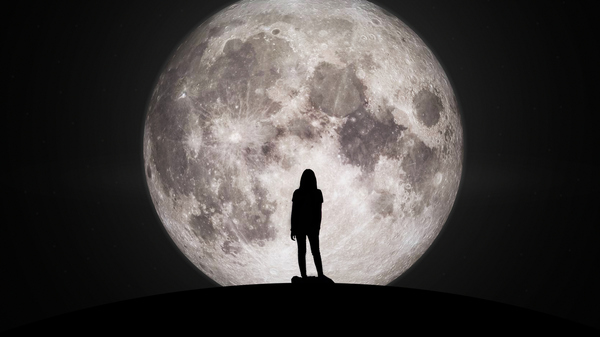Are We Moonstruck?
The power of the Moon is the stuff of legends. And science. So, how much does the Moon really affect us?

Researchers are exploring how lunar phases impact our lives. (Note: this image is an illustration.)
©iStockphoto.com/weerachonoat
A Question of Lunacy
The Moon shines as brightly in our imaginations as it does in the night sky. Since ancient times, we’ve wondered about it, waxed poetic at it, howled at it, and blamed it for everything from werewolvestomood swingstomadness.
Myths about the Moon are even baked into our language. Take the term lunatic—a Middle English word from the Latin lunaticus—which was coined out of the false belief that changes of the Moon caused outbursts of insanity.
But while some fantasies about lunar power are still widely believed, recent studies are starting to uncover compelling data about the Moon’s true influence on humans.

The term lunatic is linked to the false belief that the Moon can drive us mad.
©iStockphoto.com/RapidEye
Exploding Myths and Asking Questions
Overall, there has been little hard evidence to prove that the Moon has a measurable effect on human physiology and behavior.
But recent research exploring the data behindsome Moon myths has opened up fascinating new areas of study,suggesting we have more to learn about the lunar influence on our lives.
Bipolarity
Some researchers have found that the phase of the Moon seems to have a measurable effecton people with bipolar disorder. A 2018 study showed that patients who changed their body temperatures and sleep cycles to be in step with lunar phases were more likely to have a depressive-to-manic transition.
Menstruation
A 2016 study of 7.5 million cycles by Clue, a period tracking app, looked for a link between Moon phase and menses, but no connection was found. “We saw that period start dates fall randomly throughout the month, regardless of the lunar phase,” said Dr. Marija Vlajic Wheeler, lead scientist on the study. Another, smaller study showed some interesting nuances to this conclusion, however, finding some synchronicity that was later affected by women’s exposure to artificial light.
Murder
Looking at 6808 homicides committed in Finland between 1961 and 2014, researchers came to some surprising conclusions. They determined that there was indeed an association between Moon phases and homicides, but contrary to popular belief, there were fewer, not more, homicides on a Full Moon, especially in the earlier decades of their data. This was a relatively small study, so this is an area under further investigation.
Sleep
Research also indicates that people get less deep sleep during a Full Moon, with more of a delay in entering into REM sleep. One study showed that people took an average of five minutes longer to fall asleep and slept 20 minutes less during a Full Moon.

Can the Moon keep us awake at night? Some studies have linked the Moon phase to a slight drop in deep sleep.
©iStockphoto.com/Kanawa_Studio
Cardiovascular
There are signs that some people may experience a change in cardiovascular conditions driven by Moon phases. In a 2013 study published on the website of the US National Institute for Health, the authors speculated that the gravitational pull of the Moon may truly affect our cardiovascular system. And they noted that people’s physical efficiency increased during the new and Full Moon periods because of these lunar-driven systemic changes.
Niall McCrae, author of The Moon and Madness, summed it up this way: “We can be confident that the Moon does not have a noticeable impact on most people’s lives most of the time, but we cannot rule out the possibility of its role among various environmental factors that might affect our sleep, moods, and vitality.”
Madness and Misinformation
Outside the realm of science, there’s no shortage of mythology about the Moon’s power to drive us to distraction.
This idea has persisted throughout history, famously amplified by Shakespeare in Othello: “It is the very error of the Moon. She comes more nearer Earth than she was wont, and makes men mad”.
With this idea circulating, accused killers in 18th-century England could ask for a lighter sentence on the grounds of lunacy if the crime was committed under a Full Moon.
Still Among Us
A lot of rumors about lunar power are still circulating today.
Many of us believe it’s a bad idea to have an operation on a Full Moon. But a comprehensive study published in the Journal of Anesthesiology that looked at 18,000 surgeries at the Cleveland Clinic, focusing on a particular type of complication, found that the Moon’s phase had zero effect on the outcomes.
And as recently as 2019, the Times of India reported on a false local belief that “eating during a lunar eclipse is harmful for health, …because the eclipse leads to emission of strong ultraviolet rays, which impacts cooked food as it is prepared with water, …which turns the cooked food into poison.”

A study published in the Journal of Anesthesiology found no evidence that the cycle of the Moon has an impact on the outcome of surgeries.
©iStockphoto.com/vm
A Starring Role in Creation
Whether or not the Moon influences human behavior to any great extent, our natural satellite’s major role in enabling lifeon Earth is unquestioned.
Billions of years ago, the Moon was positioned much closer to the Earth, creating tides that were 1000 times higherthan those we see today. These huge tides stripped minerals from coastal areas and added them to the oceans, which seems to have been an essential step in allowing life to evolve quickly in the water.
Driving the Seasons
Formed as a result of a giant impact some 4.5 billion years ago, the Moon’s gravitational pull helped tilt the Earth’s axis to its current 23.5°. The Moon helps maintain this angle, allowing a gradual progression through the seasons.
Is the Moon upside-down in the other hemisphere?

The Moon helped enable life on Earth and continues to have a powerful effect on our planet.
©iStockphoto.com/DieterMeyrl
Massive Force, Powerful Light, and Gentle Tugs
The gravitational pull of the Moon, although relatively weak on the Earth’s surface, is more powerfulin the grand scheme of things than you may imagine.
In fact, Earth’s crust is pulled up several centimeters by the Moon’s force. Our oceans experience lifts measured in feet from its power. That immense pull results in Earth’s current length of day, stable seasons, and ocean tides.
And some life forms depend on lunar phases to initiate vital life cycles. Bright winter moonshine over the Arctic, for example, cues zooplankton to dive to escape predators, and rise again as the moonlight fades. There are also types of coral that base their spawning on the lunar cycle, while some sea turtle species such as Loggerheads seem to have nesting patterns that align with the Moon phases.
But while the Moon’s power is profound on the planetary scale, we humans are comparatively small organisms. So the lunar pull on our rhythms and systems, while intriguing, seems to be more on the order of a gentle tug. How much that level of force affects us will continue to be a fascinating area of research.